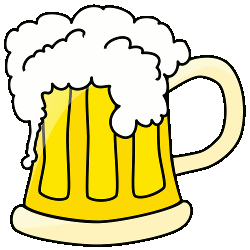Superconductivity with a Twist
March 9, 2011
Some
experiments are so strange, you're sure that
alcohol was involved. In some cases, the use of alcohol as a creativity enhancer is documented. The invention of the
bubble chamber by
Donald A. Glaser was one such story; but, alas, it's not true. Glaser was said to have gotten the idea for the bubble chamber while staring into a glass of
beer. In 2006, Glaser said the story wasn't true, although he did use beer, unsuccessfully, in his early chamber experiments.[1] Glaser won the
Nobel Prize in Physics in 1960.
Carlsberg Beer is important to the history of physics, since the
Carlsberg Foundation supported
Niels Bohr and his
Institute of Theoretical Physics. This is now known as the
Niels Bohr Institute.

The fount of quantum mechanics.
Beer profits funded Niels Bohr.
(Image from Wikimedia Commons)
There's the famous experiment, attributed to
Galileo, called the "wine-raiser," that demonstrates the difference in
density between
water and
wine. This party trick was apparently well known in Galileo's time. A glass of water is placed over a glass of wine with a partition in between. The partition is shifted slightly to allow a flow of liquid between the glasses without
turbulent mixing. Since wine is less dense than water, it will rise to the top, and the water will fall to the bottom. There a video of this
here.
Tears of wine, also known as wine legs, is the
phenomenon in which droplets fall from a ring of clear liquid at the top of a glass of wine of high
alcohol content. Alcohol has lower
surface tension than water, so wine will flow to regions of lower alcohol concentration. Alcohol, of course,
evaporates faster than water, so any liquid on the sides of the glass will have low alcohol content. This liquid will draw other liquid up to it, and droplets will fall when too much liquid accumulates. It's a world of physics in a wine glass!
Now, to the strangeness. It seems like an illogical experiment, but a group of
Japanese researchers at the
National Institute for Materials Science,
Tsukuba, Japan, decided to
marinate their
superconductors in wine.[2] Since this was
Japan, they used
Sake as well as
red wine, and their marinade was hot, not cold. Their specimens were FeTe
0.8S
0.2, an example of the class of the new
iron-based superconductors that have gotten a lot of buzz (pun intended), since magnetism has always been
inimical to
superconductivity. Such materials are superconducting only when left in the air for quite a few weeks, but the wine marinade sped things up to a single day.[2]
As described in a paper in Superconductor Science and Technology,[3] this process enhanced the superconductivity. They found that an
ethyl alcohol-water mixture didn't work as well as the alcoholic beverages. Hot, red wine at 70
o had the best affect, giving a superconducting transition temperature of 7.8 K. The implication is that it isn't merely the alcohol or water, but some other component. Red wine is red, of course, since it has
iron in it.
The reason why letting these materials stand in air, or the recently-discovered wine soak, enhances the superconductivity isn't known, but it must modify the
magnetic order of the iron atoms in some way. It was always thought that the oxygen in the air is what did the trick, and this might be the case also for the beverage soak.
As I wrote in a
previous article (Van Gogh Versus the Sulfates, March 1, 2011)
silverware tarnishes in air because of a reaction of its
oxide with
hydrogen sulfide (H
2S) to form the black tarnish product,
silver sulfide, Ag
2S,
Ag2O + H2S -> Ag2S + H2O
Those of you sensitive to
sulfites know that they're present as a
preservative in wine. There seems to be some link here between exposure of the superconductors to air and exposure to wine. I recommend exposure to
hydrogen sulfide (H
2S) gas, and a
carbon disulfide (CS
2) soak as some other experiments.
References:
- Anne Pinckard, "Invention and History of the Bubble Chamber," The Berkeley Lab View, July 21, 2006.
- Japanese scientists use alcoholic drinks to induce superconductivity, Institute of Physics Press Release, March 7, 2011
- K Deguchi, Y Mizuguchi, Y Kawasaki, T Ozaki1, S Tsuda, T Yamaguchi and Y Takano, "Alcoholic beverages induce superconductivity in FeTe1 - xSx," Superconductor Science and Technology, vol. 24, no. 5 (May, 2011), Document 055008 (Published March 7, 2011).
Permanent Link to this article
Linked Keywords: Experiment; alcoholic_beverage; bubble chamber; Donald A. Glaser; beer; Nobel Prize in Physics; Carlsberg Beer; Carlsberg Foundation; Niels Bohr; Institute of Theoretical Physics; Niels Bohr Institute; Wikimedia Commons; Galileo Galilei; density; water; wine; turbulence; turbulent mixing; tears of wine; phenomenon; alcohol; surface tension; vapor pressure; evaporation; Japanese; National Institute for Materials Science; Tsukuba, Japan; marination; superconductor; Japan; Sake; red wine; iron-based superconductors; Meissner effect; superconductivity; ethyl alcohol; iron; magnetism; magnetic order; silverware; silver oxide; hydrogen sulfide; silver sulfide; sulfite; preservative; hydrogen sulfide; carbon disulfide.